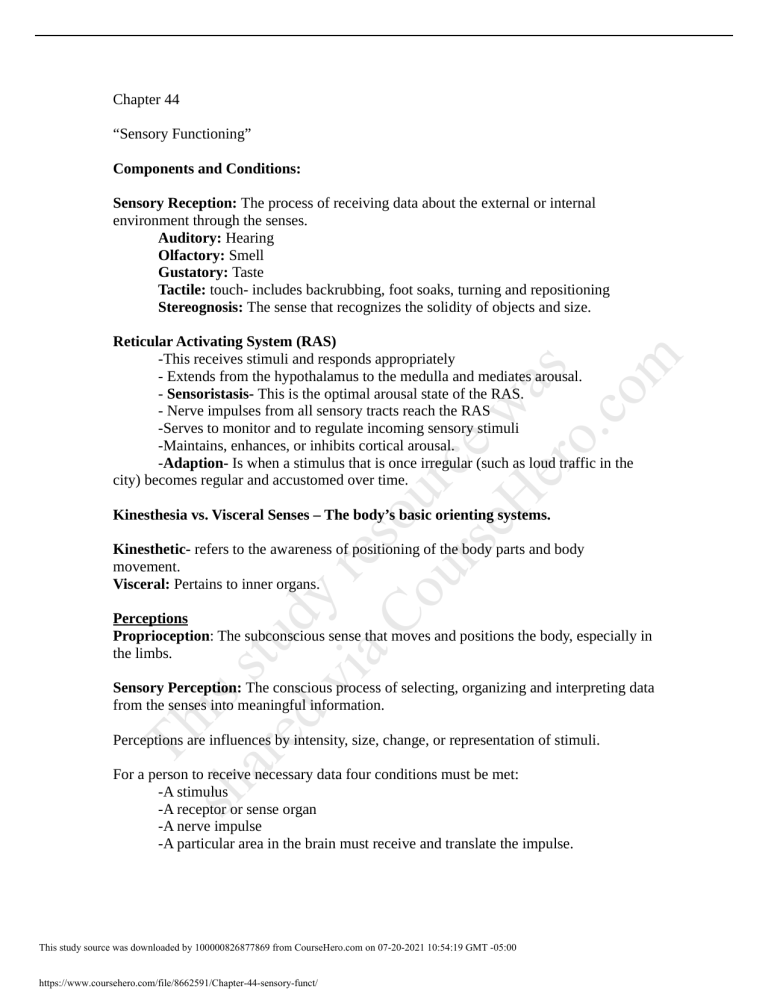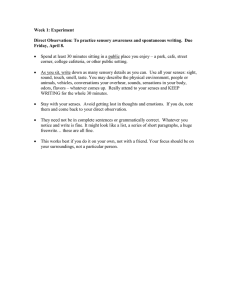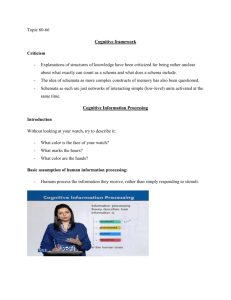
Chapter 44 “Sensory Functioning” Components and Conditions: Sensory Reception: The process of receiving data about the external or internal environment through the senses. Auditory: Hearing Olfactory: Smell Gustatory: Taste Tactile: touch- includes backrubbing, foot soaks, turning and repositioning Stereognosis: The sense that recognizes the solidity of objects and size. is ar stu ed d vi y re aC s o ou urc rs e eH w er as o. co m Reticular Activating System (RAS) -This receives stimuli and responds appropriately - Extends from the hypothalamus to the medulla and mediates arousal. - Sensoristasis- This is the optimal arousal state of the RAS. - Nerve impulses from all sensory tracts reach the RAS -Serves to monitor and to regulate incoming sensory stimuli -Maintains, enhances, or inhibits cortical arousal. -Adaption- Is when a stimulus that is once irregular (such as loud traffic in the city) becomes regular and accustomed over time. Kinesthesia vs. Visceral Senses – The body’s basic orienting systems. Kinesthetic- refers to the awareness of positioning of the body parts and body movement. Visceral: Pertains to inner organs. Perceptions Proprioception: The subconscious sense that moves and positions the body, especially in the limbs. Th Sensory Perception: The conscious process of selecting, organizing and interpreting data from the senses into meaningful information. Perceptions are influences by intensity, size, change, or representation of stimuli. sh For a person to receive necessary data four conditions must be met: -A stimulus -A receptor or sense organ -A nerve impulse -A particular area in the brain must receive and translate the impulse. This study source was downloaded by 100000826877869 from CourseHero.com on 07-20-2021 10:54:19 GMT -05:00 https://www.coursehero.com/file/8662591/Chapter-44-sensory-funct/ Sensory Deprivation - When a person experiences decreased sensory input that is dull, unpatterned, or meaningless. - The RAS is no longer able to protect a normal level of activation to brain. Patients at risk: - Those in an environment with deceased or dull stimuli - Impaired ability to receive environmental stimuli (pt. with impaired hearing or vision) - Inability to process environmental stimuli (spinal cord injury) is ar stu ed d vi y re aC s o ou urc rs e eH w er as o. co m Sensory Deprivation can lead to: - Perceptual Responses- inaccurate perception of sights, sounds, tastes, smells, body positions, coordination, and equilibrium. (Daydreams-Hallucination) - Cognitive responses- Involve the patients inability to control the direction of thought content. (Low attention span) - Emotional responses- made by apathy, anxiety, fear, anger, belligerence, panic or depression. Sensory Overload - The condition that results when a person experiences so much sensory stimuli that the brain is unable to either respond meaningfully or ignore the stimuli. - Influenced by age, culture, personality and lifestyle. Sensory Deficits -Impaired or absent functioning in one or more senses. -Examples: Impaired hearing/sight, altered taste, numbness and paralysis, and impaired kinesthetic senses. Factors that affect sensory stimulation: -Developmental Considerations -Culture -Personality and Lifestyle -Stress and illness -Medication sh Th Patients are risk for sensory disturbances: -Physiological- aging is accompanied by diminished senses. -Social and environmental factors- Need appropriate stimulation -Lifestyle- for example, engaging in work or leisure activities that are harmful to the eyes and ears. Patients at high risk for stimulation problems: - Children in nonstimulating environments This study source was downloaded by 100000826877869 from CourseHero.com on 07-20-2021 10:54:19 GMT -05:00 https://www.coursehero.com/file/8662591/Chapter-44-sensory-funct/ - Older people Terminally ill patients Bed rest patients Patients in isolation Patients requiring intensive nursing care in a critical care setting. sh Th is ar stu ed d vi y re aC s o ou urc rs e eH w er as o. co m Medically fragile infants should have limited light, visual, and vestibular stimulation to simulate being in the womb. This study source was downloaded by 100000826877869 from CourseHero.com on 07-20-2021 10:54:19 GMT -05:00 https://www.coursehero.com/file/8662591/Chapter-44-sensory-funct/ Powered by TCPDF (www.tcpdf.org)



